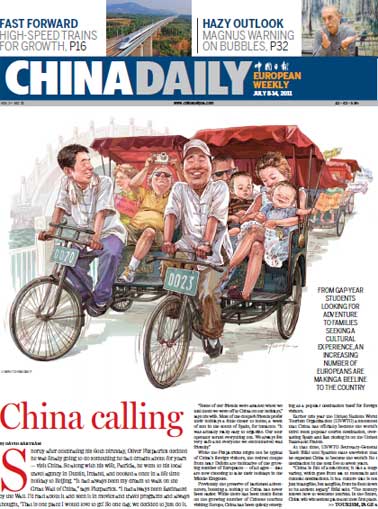A story at every corner
Updated: 2011-07-08 11:03
By Shawn Low (Chin Daily European Weekly)
Writer understands what draws hordes of visitors to China
I've traveled through seven provinces in China, hosted a National Geographic documentary in Yunnan, climbed the Great Wall as a wide-eyed tourist, traversed five different mountains as a Lonely Planet author, downed more Tsingtao than is conceivably good for me and yet, through it all, I still feel like a fly on the wall, looking at something set on a cosmically large scale.
China is huge in every sense of the word: geographically, it's over 5,000 kilometers wide, with vast desert plains, grasslands, lush valleys, snow-capped mountains, coastline and, of course, cultures as varied as its landscape. Lonely Planet's latest China guide describes it aptly, "Antique yet up to the minute, familiar yet unrecognizable, outwardly urban but quintessentially rural, conservative yet path-breaking, space-age but old-fashioned, China is a land of mesmerizing and eye-opening contradictions."
Guidebook hyperbole aside, China truly polarizes people. Throughout my travels in the Middle Kingdom, I find myself loving the place almost as much hating it. Perhaps not in equal measures, but there are certainly maddening moments. The sheer teeming mass of humanity can get very, very cloying, especially in the cities. Differences in ideas about personal space and acceptable curiosity might be mistaken by some tourists as annoying or aggressive.
It's still tough to get through quite a few areas in China. Language is a perennial issue. Shanghai and Beijing aside, communication in any language other than Mandarin is nigh impossible (but really, how is this any different for a traveler who doesn't speak Spanish going through Spain?), and the immense size of the country leaves travelers scratching their heads when planning an itinerary.
This hasn't stopped tourism numbers from growing massively. According to the Pacific Asia Travel Association, the Chinese mainland received 89 million visitors in 2001. Fast forward 10 years and the numbers stand at 142 million, a figure that is set to grow steadily by at least 3 percent year on year. Incredible numbers considering that there was SARS and a global financial meltdown in between. What about the exploding domestic travel market? Some 1.35 billion domestic trips were recorded in 2006 and air travel increased 15.8 percent in 2010.
It's not hard to imagine why there's been such growth. It's a combination of a burgeoning economy (more money equals more holidays) and China's dominance at large world events. In the space of a short few years, China is suddenly on the international radar. Of course, having money to throw at projects helps.
Witness the 2008 Olympics in Beijing. Some 280 billion yuan (29.8 billion euros) was spent on infrastructure costs alone. English signs were finally put up, transport improved and purpose-built buildings such as the Bird's Nest have become iconic in a span of two years. Expats who lived in Beijing prior might suddenly feel like they've transitioned from the "wild west" of China to a place where they can now easily get Merlot from Australia, Jamon Iberico from Spain and Brie from France.
Not one to watch its rival take all the glory, Shanghai upped the ante by hosting the World Expo in 2010. Actual event aside (it brought 73 millions visitors), the public transport and infrastructure have been completely upgraded. What does it all mean? As a writer, and more importantly, as a traveler, the one word that can accurately describe it all is "possibility". Plenty of it.
For the visitor to China today, everything is possible. Gone are the horror stories of toilets with no doors (OK, they still exist in some remote areas), or trains that don't run on time - if they even run at all. The D-class trains that run through China are fast, efficient and comfortable. The recently opened Beijing to Shanghai high-speed train now means that one can travel 1,318 km between the cities in under five hours. Or consider the Beijing to Lhasa train, the highest railway in the world. The 48-hour journey goes across the Tanggula Pass at over 5,000m. The journey itself offers a peek at the local Chinese way of travel: carriages turn into communal spaces.
I could start rattling off a hit list of "best of" China sights, but would need double the column space to even scratch the surface. Suffice to say as a travel writer, I know that I've already gotten my next pitch ready. There are over 20 provinces I have yet to see.
The author is Lonely Planet's Asia-Pacific Travel Editor.
E-paper

Shining through
Chinese fireworks overcome cloudy times, pin hopes on burgeoning domestic demand
Pen mightier than the sword
Stroke of luck
Romance by the sea
Specials

90th anniversary of the CPC
The Party has been leading the country and people to prosperity.

My China story
Foreign readers are invited to share your China stories.

Green makeover
Cleanup of Xi'an wasteland pays off for ancient city
